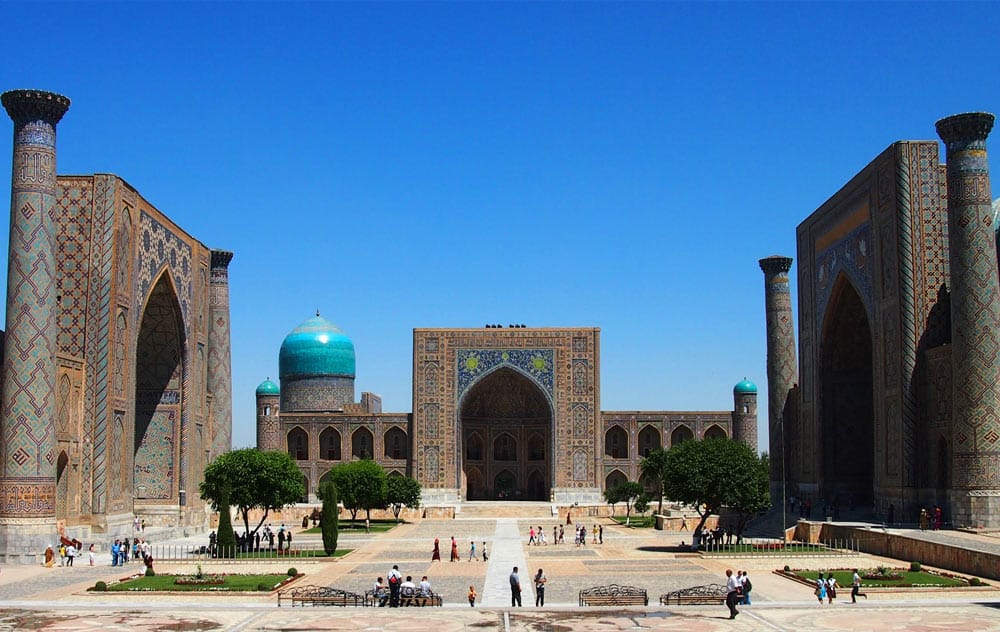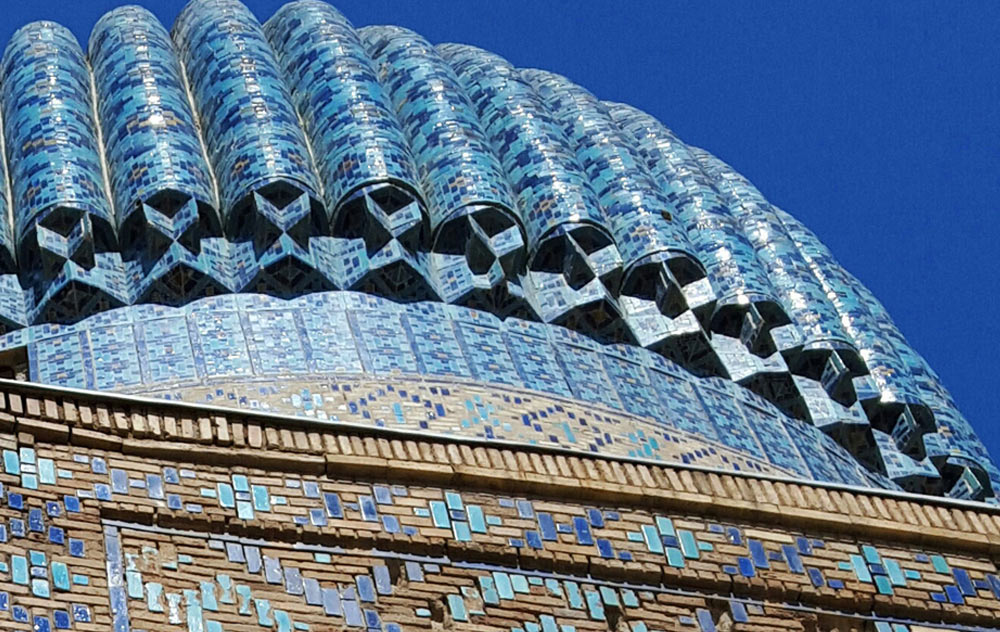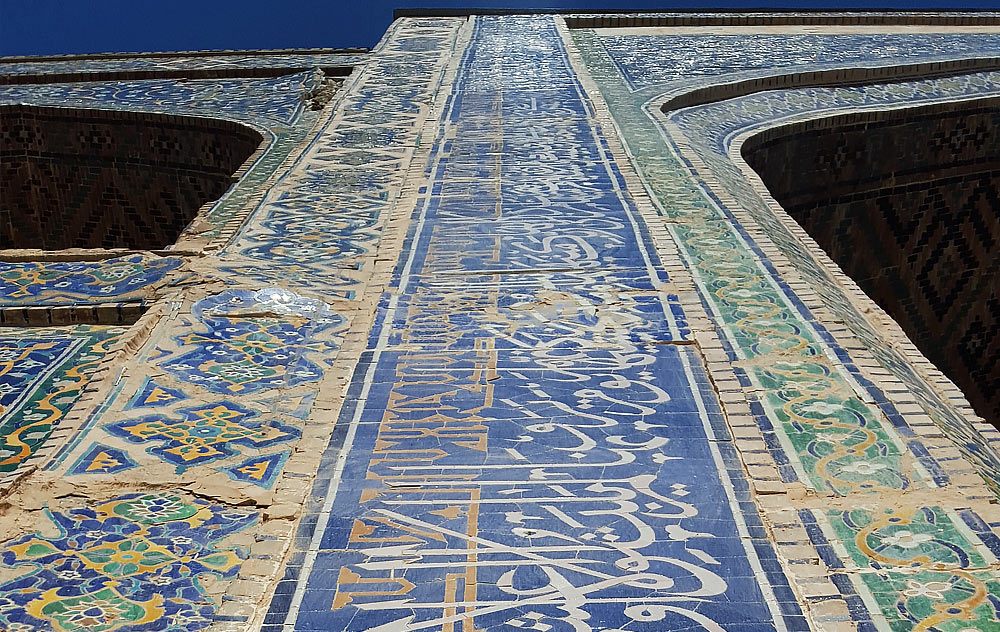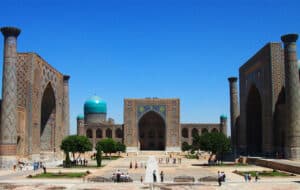Registan Ensemble Travel Guide
1. Introduction
The Registan Ensemble is the crown jewel of Samarkand, often hailed as one of Central Asia’s most magnificent historical landmarks. Comprising three grand madrasahs—Ulugh Beg, Sher-Dor, and Tilya-Kori—the Registan once served as the heart of social, commercial, and educational life in Samarkand. Its name, “Registan,” translates to “sandy place,” referencing the plaza’s function as a gathering spot long before the iconic madrasahs were built.
Historical Quote:
“Samarkand is the jewel of the world—like Rome among cities, like the sun among stars.”
– A medieval Persian proverb, often quoted by travelers who visited the Timurid capital.
2. A Glimpse into Its Past
Rise Under the Timurids
- Timur’s Vision: Although the earliest structures predate Timur, he and his successors developed Samarkand into a vibrant intellectual hub. The first madrasah, built by his grandson Ulugh Beg, spearheaded the Registan’s transformation into a monumental complex.
- Academic Excellence: Ulugh Beg Madrasah (1417–1420) became a renowned center of learning—Ulugh Beg himself was an accomplished astronomer and mathematician. Scholars from across the Islamic world traveled here to study.
Three Madrasahs of the Registan
- Ulugh Beg Madrasah (1417–1420)
- Famed for its geometric tilework and inscriptions celebrating knowledge and learning.
- Hosted lessons in astronomy, geometry, and theology.
- Sher-Dor Madrasah (1619–1636)
- Recognized by the mosaic depicting “tigers” (or lions) and rising suns—a bold iconographic choice in Islamic art.
- Symbolizes Samarkand’s creative fusion of diverse cultural and artistic influences.
- Tilya-Kori Madrasah (1646–1660)
- “Tilya-Kori” means “gilded,” referencing the sumptuous gold-leaf interior in its mosque chamber.
- Uniquely functioned as both a madrasah and a grand congregational mosque.
Traveler’s Note (17th Century):
“Here, one may study the heavens under the arches of Ulugh Beg, read the words of God beneath Sher-Dor’s fierce sun, and find gold upon every wall in Tilya-Kori.”
– Anonymous visiting merchant’s journal
3. Planning Your Visit
Best Times to Go
- Spring (March–May): Mild temperatures and blossoming courtyards. Ideal for daytime exploration and photos.
- Summer (June–August): Hot afternoons; early morning and late afternoon provide the best light and cooler weather.
- Autumn (September–November): Crisp air, fewer crowds, and vibrant sunsets for dramatic evening shots.
- Winter (December–February): Quiet and atmospheric if you don’t mind the chilly temperatures.
Getting There
- By Air: Fly to Samarkand International Airport (multiple daily flights from Tashkent). The Registan is ~15–20 minutes away by taxi.
- By Train: The Afrosiyob high-speed train from Tashkent (2 hours). A quick taxi or local bus ride from the station to the Registan.
- By Road: Samarkand is connected to other Uzbek cities by buses and shared taxis; travel times vary.
4. Opening Hours & Tickets
- General Opening Hours: Approximately 8:00 AM–7:00 PM (varies by season).
- Entry Fee: Typically 50,000 – 60,000 UZS for international visitors; local citizens and students often enjoy discounted rates.
- Where to Buy Tickets: Ticket counters located near the main entrances or at designated kiosks outside each madrasah.
5. Architectural & Cultural Highlights
- Ulugh Beg Madrasah’s Portal:
- Timurid Tilework: Geometric patterns representing celestial themes—fitting for Ulugh Beg’s fascination with astronomy.
- Inner Courtyard & Lecture Halls: Where students once studied under the shade of trees, discussing everything from mathematics to theology.
- Sher-Dor Madrasah’s Façade:
- Iconic Tiger (Lion) Motifs: An unconventional depiction in Islamic art, symbolizing Samarkand’s openness to artistic experimentation.
- Calligraphic Cartouches: Engraved Quranic verses harmoniously blended with the feline imagery.
- Tilya-Kori Madrasah & Mosque:
- Gilded Interior: The prayer hall’s dazzling gold-leaf decorations and floral motifs give a celestial feel.
- Dual Purpose: Functioned both as a religious school and a grand mosque—notice the spacious courtyard and the large dome.
- The Registan Square:
- Open Plaza: Historically used for royal proclamations, public gatherings, and market days.
- Panoramic View: Standing in the center, you can see all three madrasahs rising around you—a photographer’s dream vantage point.
6. Photography Tips: Where, When & How
Capturing the Registan demands attention to detail, timing, and angles. Here are some tips:
- Golden Hour Marvel (Early Morning or Late Afternoon):
- Sunrise Magic: Soft light illuminates the mosaic tiles with pastel hues; fewer tourists mean clearer, people-free shots.
- Sunset & Twilight: The facades glow with warm tones. As evening sets in, artificial lighting highlights the domes and archways, adding an ethereal ambiance.
- Night Photography:
- Illuminations: The Registan is sometimes lit with colorful spotlights, creating a dramatic contrast against the night sky.
- Tripod is recommended to handle longer exposure times for crisp images.
- Angles & Composition:
- Symmetry: Many doorways and facades are designed for perfect balance—center your frame on the main portal for a powerful symmetrical shot.
- Low-Angle Perspectives: Emphasize the height of the arches and domes by shooting from a kneeling or ground-level position.
- Close-Up of Tiles & Calligraphy: Zoom or use a macro lens to capture the intricate details—especially at Sher-Dor’s feline mosaics or Tilya-Kori’s gilded inscriptions.
- Avoiding Crowds:
- Weekday Mornings: Typically less crowded, giving you more unobstructed angles.
- Off-Season Visits (Late Autumn/Winter): Fewer group tours, although the weather might be cooler.
- Practical Tips:
- Lens Choices: Wide-angle lenses capture the grandeur of the square; telephoto or zoom lenses let you isolate architectural details.
- Bracket Your Shots: The contrast between bright skies and shaded courtyards can be intense. Consider HDR (High Dynamic Range) techniques for balanced exposures.
- Ask Before Photographing Locals: Always be respectful if you want to include people in your shots, especially if they’re praying or not looking to be photographed.
7. Cultural Etiquette & Useful Tips
- Modest Clothing: While no strict dress code is enforced, it’s respectful to cover shoulders and knees, particularly if you enter any mosque areas.
- Local Interaction: Uzbeks are known for their hospitality. A simple greeting in Uzbek (“Assalomu alaykum”) or Russian (“Zdravstvuyte”) goes a long way.
- Bring Cash: Many vendors around the Registan sell souvenirs and snacks, but credit card facilities can be limited.
- Stay Hydrated: Samarkand’s summer sun can be intense—carry water, especially if you plan a full day of exploration.
- Be Aware of Restoration Work: You may see scaffolding or closed-off areas. Restoration is ongoing to preserve the madrasahs’ intricate tiles. Respect any boundaries or signs.
8. Nearby Points of Interest
- Bibi-Khanym Mosque: Another Timurid masterpiece; known for its towering dome and storied past.
- Shah-i-Zinda Necropolis: A narrow lane of mausoleums adorned with exquisite tilework; excellent for vibrant close-up photography.
- Gur-e-Amir Mausoleum: The resting place of Timur, featuring an iconic ribbed dome and sumptuous interior.
- Siab Bazaar: A bustling local market for tasting fresh fruits, nuts, and local delicacies.
9. Conclusion
The Registan Ensemble offers an unforgettable blend of history, artistry, and architectural brilliance. Its soaring arches, polychrome tiles, and scholarly legacy evoke the spirit of Samarkand’s Timurid Golden Age. Whether you’re exploring the cosmic designs of Ulugh Beg, marveling at the fearless iconography of Sher-Dor, or stepping into the golden chambers of Tilya-Kori, you’ll find a visual feast at every turn—and a photographer’s paradise.
Echo of the Past:
“At Registan, the stones speak their own language—one of knowledge, devotion, and beauty,” said a 15th-century historian describing the heart of Samarkand.
From dawn’s first light warming the tiles to the twinkling illuminations after dusk, the Registan offers countless opportunities to capture the essence of Central Asia. Embrace the history, respect the sanctity, and let the camera tell your story of this legendary square.
Related Tours







